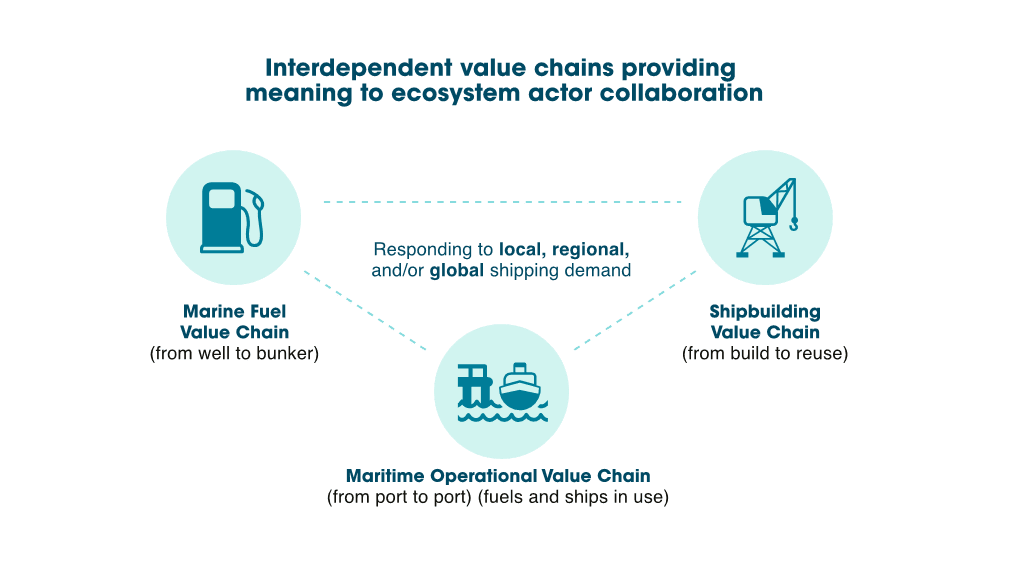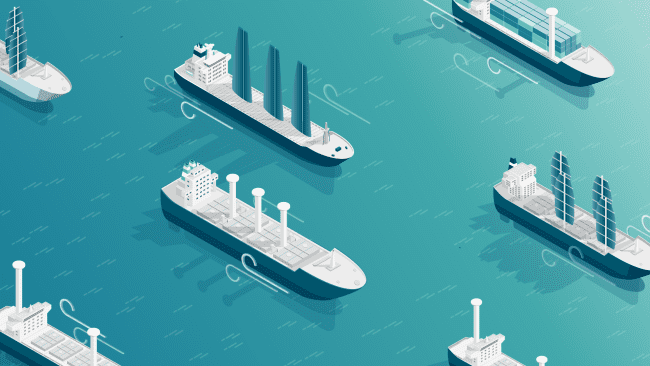Three Maritime Transition Scenarios: Uncertainty is inescapable, but we can still make good decisions today
by Mikko Forss, NAPA Design Solutions, and Pekka Pakkanen, NAPA Shipping Solutions
How can we speed up the decarbonization transition and develop a more sustainable and profitable maritime ecosystem?
At NAPA we were one of 13 companies that participated in a unique scenario-based analysis of this important question. A key outcome was that it is in the industry’s self-interest to act now, despite the uncertainties.
The analysis, carried out by a consortium led by global affairs consultancy and think tank Nordic West Office, examined three global decarbonization scenarios to look in precise detail at how the industry – in all its moving parts – might be expected to transition to green fuels over time. The coalition of contributing companies includes a range of industry leaders and experts such as Carnival Corporation, Wärtsilä, Meyer Turku shipyard, Aalto University, and the International Chamber of Shipping.
Uncertainty is inescapable at present, and outlining such scenarios is a good way of stress-testing strategies, guiding us towards decisions that are most likely to be robust and attractive.
Storms, Swells and Clear Skies
The scenarios analyzed were developed and adapted for shipping based on the Shell Energy Transformation scenarios. “Storms” is a scenario where nationalism, geopolitical conflicts, and a worsening climate crisis results in reduced global knowledge exchange and coordination. This results in failure to meet both the Paris climate goals (to limit the global average temperature rise to well below 2°C above pre-industrial levels) and the IMO 2018 decarbonization ambitions (outlined in its Carbon Intensity Indicator regulations).
In the “Swells” scenario, businesses and governments concentrate on growth. Decarbonization advances slowly until the climate crisis intensifies and disrupts shipping and ports. Quick, abrupt change is needed and finally initiated, but is costly. This late action is not enough to reach IMO 2018 ambitions, but eventually, the Paris goals are met.
The “Clear Sky” scenario produces the best outcomes from a decarbonization perspective as stakeholders worldwide are aligned to common goals. The private sector takes initiative individually and collectively, and policymakers support their efforts. In this scenario, the Paris goals are met, but the IMO 2018 ambitions are not.
In short, the report indicates that shipping is not on track to meet the IMO’s current short-term goals. We are operating in a “Swells” environment and at risk of heading towards “Storms”, but by acting now, we can avoid the exponentially rising decarbonization costs anticipated if action is delayed until it becomes critical. Importantly, taking action now is a non-regret strategy and indispensable for achieving the Paris goals.
Collaborating to tackle decarbonization
The study’s primary suggestion for changing to our current trajectory is to tackle decarbonization comprehensively and collaboratively – calling on regulators, shippers, shipowners, investors, fuel suppliers, ports, and other stakeholders to prevent “gaps” in the industry-wide effort. A strong focus on green fuel supply chains is needed, as well as other enablers such as Just In Time (JIT) arrival, improved routing, and energy-saving measures such as the adoption of wind-assisted propulsion.
Many of these enablers are available today, and we need to remain flexible and develop different enablers for different cases and sustained profitability. Investors need to have as much clarity as possible about emissions targets, carbon pricing, and technical and operational requirements.
Logically, it is useful to consider three target areas: the marine fuel value chain, the shipbuilding value chain, and the maritime operational value chain. All of these chains are highly interdependent; allowing for the most effective decarbonization, therefore, means aligning supply and demand across this cluster of chains. The alternative marine fuel supply chain needs to supply enough fuel for ships with alternative fuel engines that are demanded by ship owners / operators / charterers given the demands of each sub-sector.
We can then establish cross-value chain coordination to avoid gaps and bottlenecks. For example, we currently have dual-fuel engines but not enough alternative fuel. Initiatives such as the development of zero-emission corridors are a good example of how we can consider value chains holistically and simultaneously from carbon calculation, design, planning, financing, management, and policy-making perspectives to make significant progress.
The uptake of alternative fuel is a key enabler that cuts across all three value chains, but many alternative fuels still need to prove their long-term cost competitiveness, particularly because they have a big impact on ship design, engines, tanks, storage, bunkering, and ship operations.
Another key enabler is technology. New and upscaled production technology is needed to produce clean marine fuels, advanced ship engine technology is required to make use of these fuels, and digital technology is needed to support fuel-efficient operations and drive costs and fuel consumption down. This reduces competition for these fuels and the renewable energy needed to produce them.
To achieve significant decarbonization, we need a coordinated and concerted effort from people across the globe. A fragmented “Storms” world will not succeed, and it would be a missed opportunity to accelerate clean innovation which would create new opportunities for growth and jobs.
The private sector has the power to accelerate decarbonization no matter what the scenario. Leading players in the industry need to show what works and what doesn’t so that other public and private stakeholders are better informed when making their own decisions.
Where next? NAPA’s role in the solution
NAPA is playing a pivotal role in the decarbonization transition, across many value chains, from vessel design to operation and safety. We help stakeholders make the right decisions on how to transform the way that vessels operate, using better data to sail smarter and reach the industry’s goals faster. In particular, as part of the Blue Visby consortium, we are using our technology to enable a new contractual framework for maritime voyages, where we can finally tackle the misaligned incentives that drive ‘Rush to Wait’ behavior.
We look forward to putting the “Swells” and “Storms” behind us as we sail towards the “Clear Sky” of a more sustainable and more profitable maritime ecosystem. The final recommendation of the report, is to “Act now! In our self-interest to avoid exponential decarbonization costs.” Many enablers exist that can make this happen, without waiting for new technology or fuels to scale up. Adopting the Blue Visby solution, for example, can reduce emissions among participating vessels by up to 16% just by agreeing to sail at optimized speeds. Designers and operators can use our stability expertise and tools to ensure that safety is a prerequisite for installing any new technology. We have a steep hill to climb, and any steps we take now will make the route smoother later on.



